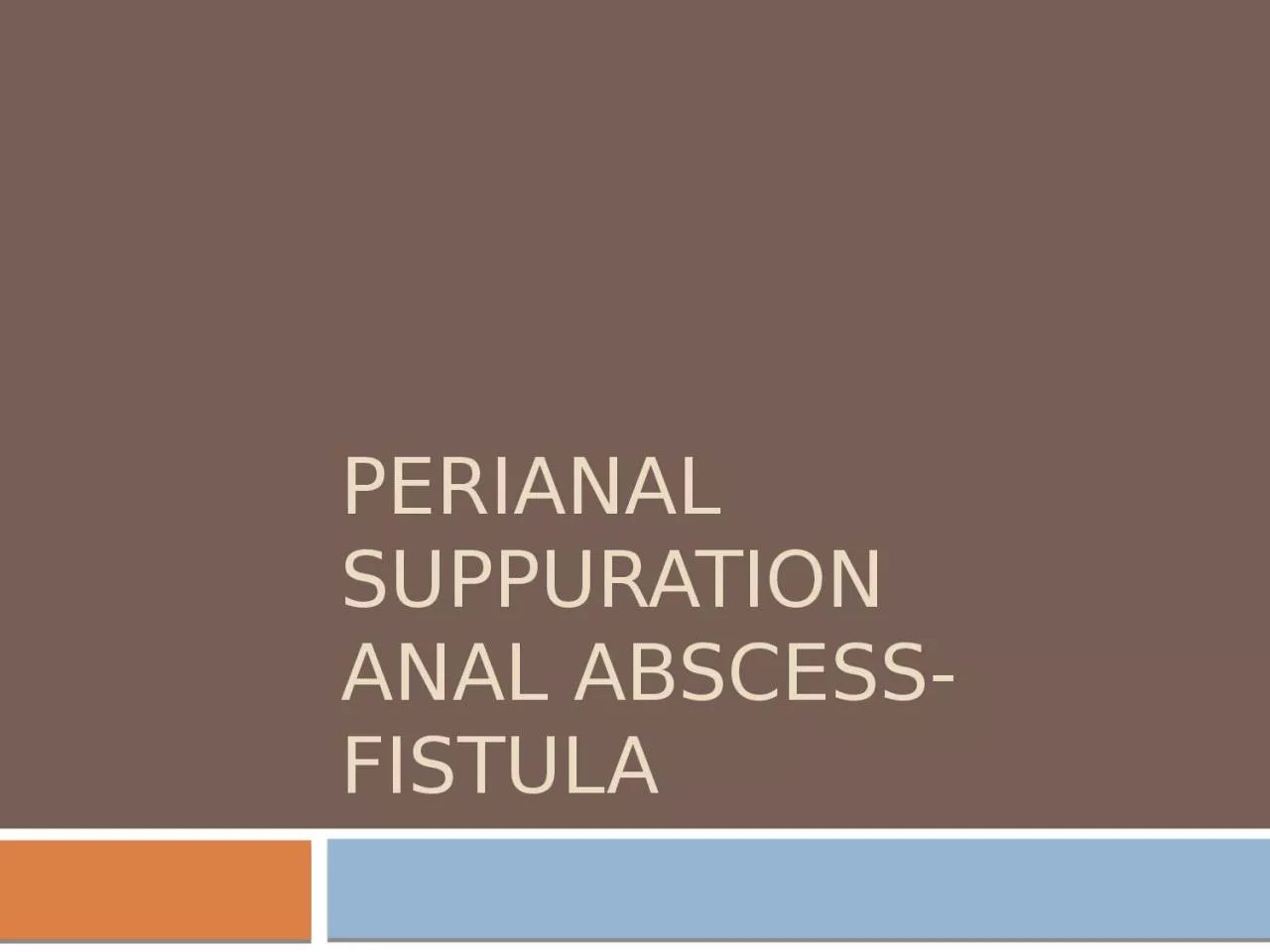

Anatomy anal glands anal glands The average number of glands in a normal anal canal is six range 310 Each gland is lined by stratified columnar epithelium with mucussecreting or goblet cells interspersed within the glandular epithelial lining and has a direct opening int ID: 1006489
Download Presentation The PPT/PDF document "Perianal suppuration anal abscess-fistul..." is the property of its rightful owner. Permission is granted to download and print the materials on this web site for personal, non-commercial use only, and to display it on your personal computer provided you do not modify the materials and that you retain all copyright notices contained in the materials. By downloading content from our website, you accept the terms of this agreement.
1. Perianal suppurationanal abscess-fistula
2. Anatomy anal glands
3. anal glandsThe average number of glands in a normal anal canal is six (range, 3–10) Each gland is lined by stratified columnar epithelium with mucus-secreting or goblet cells interspersed within the glandular epithelial lining and has a direct opening into an anal crypt at the dentate line.Occasionally, two glands open into the same cryptHalf the crypts have no communication with the glands
4. anal glands
5. Perianal spaces
6. Perianal spaces
7. Horseshoe-shaped connections of the anorectal spaces.
8. EtiologyCryptogenic or cryptoglandular Specific ones include the following: Crohn’s disease, chronic ulcerative colitis Actinomycosis, lymphogranuloma venereum tuberculosis (TB) foreign bodycarcinoma, lymphoma, leukemiatrauma (impalement, enemas, prostatic surgery, episiotomy, hemorrhoidectomy)RadiationChronic anal fissure
9. Cryptoglandular diseaseThe anal glands were found to arise in the middle of the anal canal at the level of the crypts and to pass into the submucosa. two-thirds continuing into the internal sphincter one-half penetrating into the intersphincteric plane
10. Cryptoglandular diseaseObstruction of these ducts, whether secondary to fecal material foreign bodies, or trauma, results in stasis and infection chronicity is due to persistence of the anal gland epithelium in the part of the tract joining the internal opening or to nonspecific epithelialization of the fistula tract from either the internal or external openings than to a chronically infected anal glandDestruction of the anal gland epithelium might explain the occasional spontaneous healing of a fistula
11. Acute phase (abscess)symptoms acute pain and in the anal region. Pain occurs with sitting or movement and is usually aggravated by defecation and even coughing or sneezing. Swellingpurulent anal discharge preceding bout of diarrhea bleeding General symptoms include malaise and pyrexia
12. BacteriologyEscherichia coli (22%) Enterococcus spp. (16%)Bacterioides fragilis (20%)
13. Acute phase (abscess)FindingsTender indurationPus may be seen exuding from a cryptExamination under anesthesia is not only justified but also indicated Supralevator abscess, a tender mass in the pelvis may be diagnosed by rectal or vaginal examination. Abdominal examination may reveal signs of peritoneal irritation
14. Acute phase (abscess)location
15. Avenues of extension for an anal fistula
16. Diagnosis and treatmentPhysical examinationExamination under GAMRITreatment by drainageAntibiotics if immuno-suppressed , SIRS, deep and local spread,
17. Drainage of a supralevator abscess
18. incision and drainage of a horseshoeabscess.
19. chronic phase (fistula) historythe patient’s history will reveal an abscess that either burst spontaneously or required drainage small discharging sinus
20. chronic phase (fistula) External opening usually can be seen as a red elevation of granulation tissue with purulent serosanguinous discharge on compression. Opening is sometimes so small that it can be detected only when palpation around the anus expresses a few beads of pus
21. chronic phase(fistula)An external opening adjacent to the anal margin may suggest an intersphincteric tract A more laterally located opening would suggest a transsphincteric oneThe further the distance of the external opening from the anal margin, the greater is the probability of a complicated upward extensionincreasing complexity and increasing laterality and multiplicity of external openings also has been observed
22. chronic phase(fistula) palpate the skin since with a superficial fistula a cord structure can be felt just beneath the skin leading from the secondary opening to the anal canalinternal opening might be palpable crypt of origin is often retracted into a funnel by pulling the fibrous tract leading to the internal sphincter; this state is called the funnel, or ‘‘herniation sign’’ of the involved crypt
23. Goodsall’s rule
24. Probing of the fistulous tract
25. INVESTIGATIONAnoscopy and sigmoidoscopyFistulographyEndoanal UltrasonographyMagnetic Resonance ImagingEndoanal Magnetic Resonance Imaging
26. Fistulography
27. Endoanal Ultrasonography
28. MRI
29. FISTULA-IN-ANOINCIDENCEMen predominate in most series with a male-to-female ratio varying from 2:1 to 7:1 Age distribution is spread throughout adult life with a maximal incidence between the third and fifth decades
30. FISTULA-IN-ANODEFINTIONSCOMPLEX; more than one tract (branching)HIGH; the main tract or a branch passes to the level of anorectal ringHORSE-SHOE; the tract passes on both sides of the midline
31. INCIDENCEInter-sphincteric, 70%Trans-sphincteric, 23%;Supra-sphincteric, 5%Extra-sphincteric, 2%.
32. FISTULA-IN-ANO types
33. FISTULA-IN-ANOprinciples of managementthe primary opening of a tract must be identifiedthe relationship of the tract to the pubrorectalis muscle must be established; division of the least amount of muscle in keeping with cure of the fistula should be practiced;side tracts should be soughtthe presence or absence of underlying disease should be determined
34. Intersphincteric fistula: simple low tract
35. Intersphincteric fistula: high blind tract
36. Inter- sphincteric fistula: high tract with a rectal opening
37. Inter- sphincteric fistula: secondary to pelvic disease
38. Trans- sphincteric fistula: uncomplicated type
39. Trans- sphincteric fistula: high blind tract
40. Supra- sphincteric fistula: uncomplicated type
41. Suprasphincteric fistula: high blind tract
42. Extrasphincteric fistula: secondary to anal fistula
43. Fistulotomy
44. Fistulotomy vs. fistulectomy
45. Seton insertion
46. Advancement rectal flap
47. Dermal Island Flap Anoplasty
48. Other proceduresFistulectomy and Primary ClosureVideo assisted anal fistula treatmentCutting SetonFibrin GlueAnal PlugLift Technique Ablation, LASER
49. Fibrin Glue
50. Video assisted anal fistula treatment
51. Anal Plug
52. Intersphincteric fistula tract removal
53. Necrotizing infection